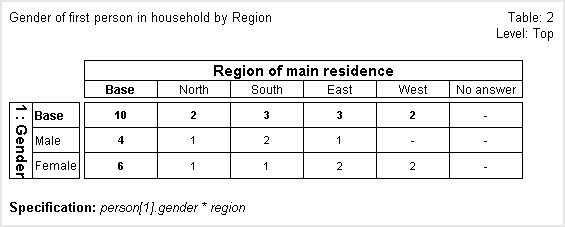Tabulating a slice of a numeric loop
You can use a slice of a numeric loop in a similar way, provided the loop is defined as expanded. In a numeric loop, the iteration ID is a numeric value, rather than a category name. For example, suppose you want to tabulate the gender of the first person in each household by the region. You would do this as follows:
1 Create a new table.
2 In the Variables pane, expand the person loop, and then expand the gender variable that is inside the person loop.
3 Select the first slice (1), and then click Add on the side of the table.
4 In the Variables pane, select the region variable, and then click Add on the top of the table.
5 Click the Generate table button

.
Here is the table:
Table showing gender by region of main residence
Notice that in this table, the label in the side axis is "1: Gender". When you use a slice of a grid or loop in a table, the full label is used instead of the normal label. This makes it clear which slice is being used, because, by default, the full label is the label prefixed by the iteration name.
When working in the hierarchical view the default generation level for a table is generally the lowest common ancestor level of all the filters and variables that are included in the table (including variables used in cell contents). However, when a table contains a grid slice at a lower level than any other variable included in the table, the default level will be the level above the grid slice. This is because, when tabulating a grid slice, it is more common to want to show the number of cases at the next level up rather than the number of responses at the grid level. However, you can choose to generate the table at the level of the grid slice if necessary.
See also
 .
.